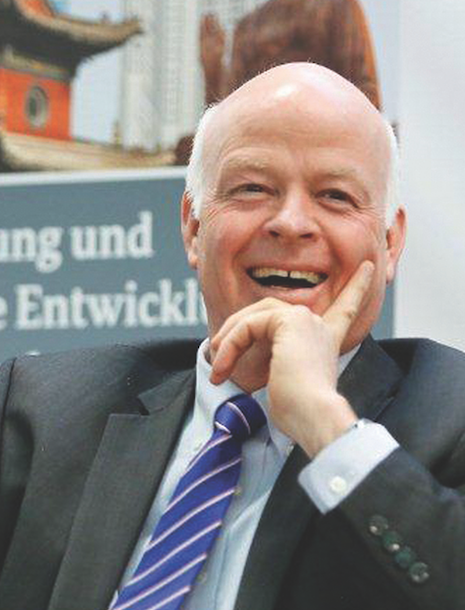
Photo: Screen-Shot-2016-10-20-at-12.25.55
Habitat III: how will cities finance the New Urban Agenda?
05 October 2016
by Jonathan Andrews
Cities Today asked a panel of urban experts prior to Habitat III and asked what is needed to kickstart the financing of city infrastructure
What role will your institution play in assisting cities to implement the New Urban Agenda?
 William Cobbett, Director, Cities Alliance
William Cobbett, Director, Cities Alliance
Since its inception in 1999, Cities Alliance has been promoting an agenda to assist cities and national governments to respond productively to the opportunities and challenges resulting from urbanisation and city growth. We will continue this trajectory with a growing membership and partnerships. We are very happy to see that with the New Urban Agenda in place we have a number of concrete opportunities to realise the global commitments in the Agenda 2030.

Ellis Juan, Division Chief, Urban Development and Housing, Inter-American Development Bank (IDB)
Our institution will work on three different fronts to improve the urban financing agenda over the next 20 years.
First, strengthening the fiscal sustainability and governance of cities. We believe that unless we improve the credit rating of a city and its perception by the capital markets, mobilising resources for urban infrastructure development will always be an uphill battle.
Second, helping cities prepare good projects for the financial markets. Pre-investment preparation (and costs) are normally not part of a city’s annual operating budget. As a result urban infrastructure projects are poorly prepared (i.e. they lack a feasibility study, market analysis, legal structuring, financial structuring, etc.). When this happens, projects are often not even considered by investors, they take a long time to reach financial closure and they disappear from the stage due to lack of interest. Preparing good projects will not guarantee a city access to long-term funding, but it will definitively improve its chances.
Pre-investment costs for the expansion of a water treatment plant, or for a BRT public transport system, or for an integrated solid waste management system can run between US$ 1.5 million and US$3 million or more. Not many cities can count on this type of budget allocation from their internal sources. Multilateral development banks and donors can play a role in setting up a Trust Fund that could initially fund these activities to later be recuperated in the transaction costs at financial closing.
Third, we need to provide financial support to improve access for cities to long-term capital.
Even with the two previous steps, we believe some type of financial support from AAA rated institutions like the IDB would be needed in the first ten to fifteen years to help cities access capital markets. Using guarantees from institutions like MDBs for financing structures for urban infrastructure will improve city credit ratings, enable them to obtain longer tenors and improve acceptability by investors while a learning curve is being followed.
 Vijay Padmanabhan, Technical Advisor for Urban Development at the Asian Development Bank (ADB)
Vijay Padmanabhan, Technical Advisor for Urban Development at the Asian Development Bank (ADB)
We are currently working on our urban sector strategy for 2030. There are a couple of areas where we think there are going to be a lot of importance over time. Migration and jobs/employment will play a critical role in terms of the type of services and facilities that cities need. That’s where ADB will be focusing more: special economic zones, economic corridors, and tourism circuits, areas where jobs and employment are clearly defined. Going more into the city space, we’re trying to have a clear demarcation of secondary cities in a few countries to focus on the planning aspect and then looking at the financial management aspects and looking at partnerships with utilities or other cities from countries where we can improve the institutional aspects. We’re starting off with 20 to 25 cities. That’s going to be very focused and we’re already testing out a few concepts through our Future Cities Programme, where we’re looking at a multi-disciplinary approach to finance, credit-worthiness and mobility systems, in five cities across Asia Pacific.
 Sameh Wahba, Global Practice Director for Urban Development, Disaster Risk Management and Resilience, World Bank
Sameh Wahba, Global Practice Director for Urban Development, Disaster Risk Management and Resilience, World Bank
The way we approach sustainable urbanisation through an integrated approach is through three pillars: planning, connecting and financing. Planning is meant to hinge on supporting cities and leaders in putting in place for growth, for inclusion, for greening their cities, making them more competitive. The foundation there is land markets. If you don’t know who owns what in terms of land, where this land is located, and you don’t know the most appropriate use of that land, then there’s very little that you can build. You need functional land markets to build sustainable urbanisation. Connecting is about connecting firms to market, and connecting people to jobs. It is not just about putting in place transportation systems, its about an integration of land use, with transportation that can ensure the most efficient city. If you have city sprawl, it will take you 100 to 150 years of lock-in because of the amount of infrastructure that’s needed and the amount of cost the goes into it, it’s very hard to alter. The third pillar is financing, or how to finance all this infrastructure. You’ll notice I’ve mentioned this at the end. This is because, if you don’t have planning or connecting, you will be financing inefficiencies.
The latest draft of the New Urban Agenda offers little insight into how cities are going to finance their development though it calls for a ‘paradigm shift’ in how we finance cities. How should this be addressed in Quito and beyond?
Cobbett, Cities Alliance
At the Habitat III Conference, it would be useful to build a financing agenda based on recognition of the following facts and trends:
- There are environmental infrastructure deficits (water, sanitation, solid waste management) that need long-term finance that current government grants cannot meet if change is to be systemic.
- Trends since the 1990’s point towards a greater delegation of responsibilities to local levels of government that are unmatched by the corresponding authority to plan, design, invest and pay for the needed infrastructure.
- The continuing inflow of people into cities of all size makes an institutional response imperative for financing basic public goods.
A key role of the conference could be to initiate activities to support national rollouts of programmes to conduct audits, collect financial statements and ultimately lead to credit ratings for cities and countries. This would allow national governments to introduce programmes to wipe out debts, determine the liquidity of local governments and establish which local governments would have credit worthiness in order to raise their own capital.
Juan, IDB
Unfortunately, there is no “quick fix” or “paradigm shift” when facing the challenges of how to finance urban infrastructure. It is all “back to basics” but do it better this time. Cities have three basic sources of funding for urban infrastructure:
- Tariffs (end user prices). Cities are not living in a perfect world and with the exception of telecommunications (mostly privatised), and energy, other urban infrastructure sectors have their end-user tariffs at levels below full cost recovery (i.e., water and sanitation, solid waste, urban transport, social services). In our experience in LAC, with the exception of telecoms and energy, average cost recovery tariffs are between 40 to 50 percent.
- Subsidies (complement to end-user tariffs). Because there are urban infrastructure sectors that carry with them important positive externalities, this pushes policy makers to provide services to citizens via subsidies. Most of these subsidies come in the form of federal (or national) government transfers.
- A city’s own budget. If cities had important surpluses in their operational budget they could fund urban infrastructure from internal sources. Unfortunately with a few exceptions (some large capitals), our cities in the region on average dedicate less than 10 percent of the total city budget to investments and such amounts are very far from cities’ annual needs.
Besides these three basic sources, cities that perform financially well, have the possibility of a fourth source, third party funding (private capital). But, if you are a city, with relative poor credit ratings, weak financial history in capital markets, with low levels of institutional capacity and governance, and with several doubts as to your fiscal sustainability then the picture is very different. The private sector will still be looking for business, but only where there is a strong backing (“guarantee”) from the federal or national government or from a triple A institution. Unfortunately in our region (LAC) most cities, with the exception of some capital cities, belong to this second category of cities.
Wahba, World Bank
As far as the financing of the New Urban Agenda goes, there is really no silver bullet solution. To be able to finance the urban infrastructure finance gap in developing and emerging economies, which is a first building block to contribute to the New Urban Agenda, by very rough estimates we are talking about figures in the range of a trillion dollars a year. The figure becomes much higher if we take into account the needs for improved resilience of this urban infrastructure. Such figures dwarf Official Development Assistance (ODA) which is about US$125 billion per year, so this is just a drop in the ocean. The only way to be able to finance urban development at scale is to have both cities and national governments working together to enhance their resource mobilization, innovate such as through the use of land value capture instruments, and leverage financing from the private sector and capital markets. So for cities that means enhancing their revenues, rationalising expenditures, building robust and transparent financial management systems, leveraging their assets, structuring viable PPPs, and gradually building their path towards creditworthiness, while for national governments this means putting in place an effective enabling and regulatory for local government finances and to strengthen their intergovernmental fiscal transfers systems among other activities. In other words, all the building blocks of sound financial management need to be put in place.
What specific type of financial instruments require expansion in order to support local governments’ improvement of infrastructure in cities of the least developed countries?
Juan, IDB
Most likely the use of partial credit guarantees (i.e., first loss, rolling guarantees, etc.) will be used more often to help mobilise private capital into urban infrastructure. The experience of MDBs with partial credit guarantees, so far, has been limited. Some adaptations to the policies regulating the instrument will have to be implemented for more effective use.
Padmanabhan, ADB
In the last ten years, ADB has been promoting a financing facility called the multi-tranche financing facility which takes a much more phased approach, finances a slice of the government’s investment programme and starts developing the institution along with the infrastructure and services. That’s a facility that we’ve actually worked well with and given the long-term engagement we need to have with cities, this is a facility that we are likely to use a lot. We’ve also been using a new modality called results-based lending which looks at results and outcomes and that’s structured along with a government programme.
Wahba, World Bank
There are those financial instruments that the municipalities need, where we can help them through a combination of technical assistance and leveraging, such as our guarantees, that are helping issue municipal bonds or helping structure land value capture instruments. Or, tax increment financing, as used in the US. So, with municipal bonds, land value capture instruments etc, there are functioning municipal financing instruments that we can help scale up. But the issue isn’t to have the normative financial engineering, even though that is always welcome, the issue is how to help build the fundamentals: modern municipal accounting, public financial management systems, and the policy and regulatory frameworks that could help those municipalities both borrow and leverage the value of land.

What scope is there for development impact bonds and green bonds to help cities to achieve their targets?
Cobbett, Cities Alliance
Without a borrowing framework – not necessarily bonds but also other forms of credit- it would be impossible to finance longer-term assets. It might be useful at the Habitat III conference to develop a typology of financing situations so that there is a variable policy response that takes into account differences in national institutional conditions. Three types could serve as examples:
- Type 1 – The domestic debt markets are yet to mature and the devolution framework is weak – Assist cities with loan-grant blends while improving the devolution system-see for example Nepal, Senegal, Tajikistan, Bangladesh
- Type 2 – Debt markets are constrained by fiscal space, but devolution is more secure-work with domestic financial institutions to lengthen maturities and reduce transaction costs- see for example Vietnam, Sri Lanka , Ghana, Morroco
- Type 3 – Markets have begun to mature, and devolution is secure, so provide instruments to link city financing with domestic markets, especially for small and medium cities- see for example Indonesia and the Philippines
Juan, IDB
Financially, there is nothing particularly different about a green bond compared to any other kind of bond. In simple words a “green” bond is just “green” because it is associated with a sustainable urban infrastructure intervention that will have an impact (mitigation or adaptation) on climate change. If the underlying economics of the bond (risks and rewards) are not solid, the “green” factor will not make it more attractive to capital markets. This is what happened when the Carbon Markets (CDRs) tried some years ago to push “green” investments. We all know where it went.
Padmanabhan, ADB
My perspective on this is that it eventually depends on a couple of key parameters. One is the institution’s internal capacity to handle the servicing of the bond itself to give the lending agency or subscribers to the bond more confidence, and there is going to be a level of comfort in terms of terms and conditions. But it also depends on who the guarantor is and their level of financial robustness. ADB has partial credit guarantees that we have applied to a limited extent but is something that we will look to apply in China and other upper middle-income countries.
Wahba, World Bank
In principle the scope [for such bonds] is significant, but in reality you need to start with the underlying conditions. You need to have modern municipal accounting systems, and you need to enhance revenues, and you need to rationalise the expenditures if those cities are ever going to go into sustainable municipal borrowing. If you don’t have the basic systems in place, you don’t have sustainable municipal borrowing. If a city wants to issue a green bond, it has to first be able to issue a regular bond.
How can investor confidence be won given that cities in developing countries are not deemed creditworthy by international markets?
Cobbett, Cities Alliance
Risk is commensurate with investment. Banks will not lend money to public and private interest if there credit worthiness is very low. Investor confidence in local governments will only be improved if steps are taken to reform local governments and introduce modern accounting and financial management systems. There is a challenge in this, because it requires technologies and skilled people to manage the systems. Local governments in many partner economies continue to lose staff, so capacity is being continually depleted. We need a serious international and national effort to make working in local government more attractive.
Juan, IDB
Our point for the New Urban Agenda is that cities that have weak credit will need to improve that rating to be able to have access to local financial markets. Initially, if your municipal risk is unknown to an investor in such markets you’re going to need some credit enhancement to facilitate an initial placement. It will take a learning curve of 10 to 15 years for local financial markets in our region to fully understand and accept urban infrastructure bonds (municipal bonds).
Padmanabhan, ADB
If you look at the cash flows between cities, provincial governments or central governments, there is still a huge reliance on subsidies in terms of transfers. At the end of the day, it all depends on how a city manages its expenditure and how it manages its revenue base and how much control it has over that. The only way we can actually improve this creditworthiness is by focusing and working with cities where we can see the return on investment and any improvement on the city’s own balance sheet is used to provide services in a better fashion.
Wahba, World Bank
The answer is the fundamentals. You need the fundamentals in terms of the municipal finance systems, and you need institutional frameworks at a national level. You don’t have any legislation that governs municipal borrowing, and you find a lot of ministries of finance that don’t want to sanction this liability, because it can be a huge liability.
In terms of specific measures, the New Urban Agenda says that countries will support the setting up of a multitrust fund by UN-Habitat for capacity development. How do you envisage such a fund working in practice?
Cobbett, Cities Alliance
Due to a number of national and international reasons, the international aid architecture is rapidly transforming and so are the instruments of development. We have been closely aligning our way of collaboration since the Paris Declaration in line with the Busan principles for effective cooperation. So any new ideas for setting up complementary pooling and cooperation mechanisms to support investments in cities may need to have a clear reality check of what works and for whom. This may not be an easy task and requires not only a stronger cooperation across the United Nations System but most importantly a stronger involvement of local governments associations, foundations and the private sector to increase our coordinated development impacts in cities.
Juan, IDB
We are working on a regional draft proposal with UN-Habitat to be presented at Habitat III in Quito. Unfortunately we cannot share the proposal with you at this stage. However, it revolves around the multi-donor trust fund concept with the three windows I touched on before. The challenge is to structure it in a way that can be locally executed and targeted to local currency financial markets.
Wahba, World Bank
It’s a work in progress. It’s important to have financing decisions by companies to invest appropriately in enabling sustainable urban development. That is not only through their own investment into the multitrust fund but also in investment in a regulatory framework and structuring an intergovernmental fiscal transfer system, so that’s definitely critical. The two most critical pillars are investing in strengthening the conditions that can leverage the capital markets, because whatever funding the public sector has, it’s a drop in the ocean relative to the investment needed. You need to figure out a way to bring in the capital markets, pension funds and long-term capital.











